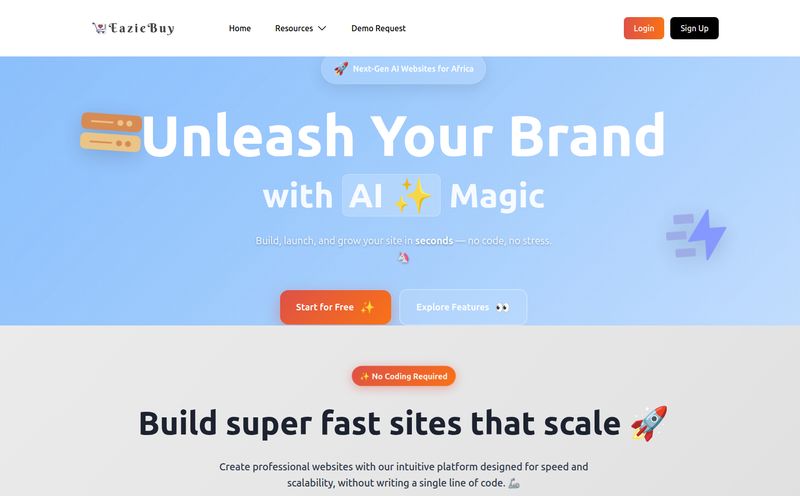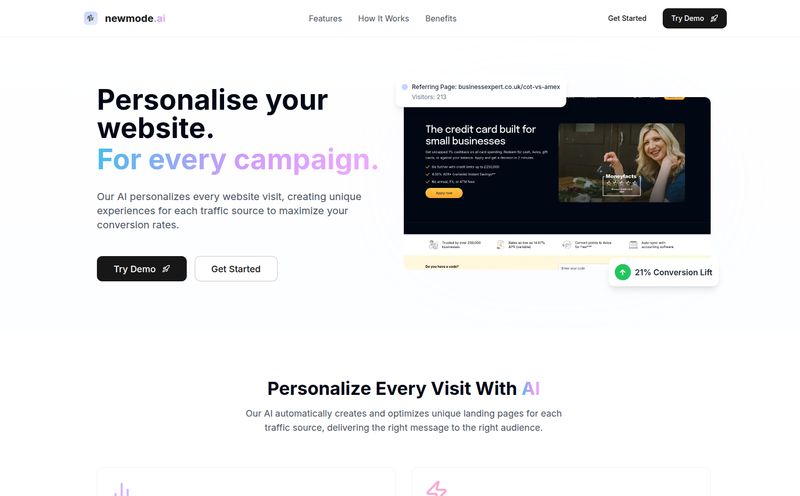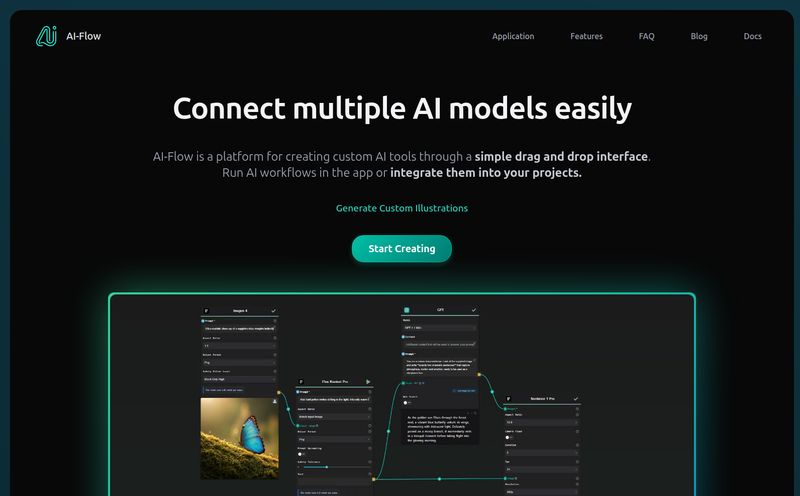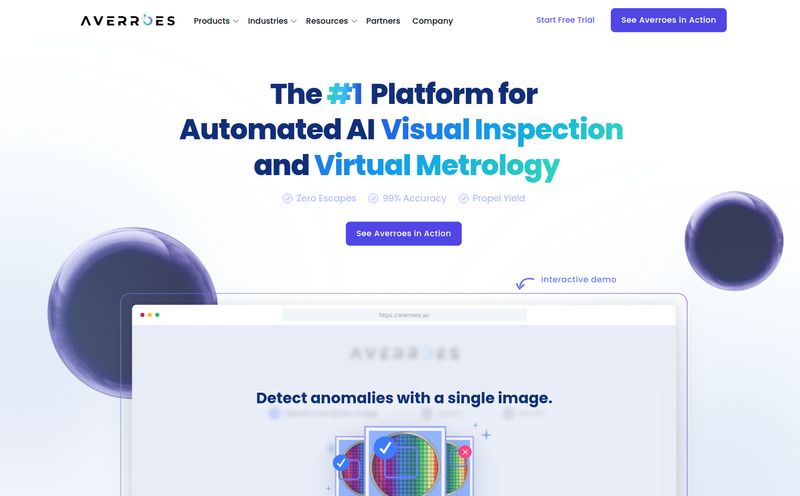If you’re a founder, an indie hacker, or anyone trying to get a project off the ground, the last thing you want to do is spend three weeks wrestling with a website builder. We've all been there, right? Staring at a blank WordPress dashboard, wondering which of the 50,000 plugins you actually need, all while your brilliant idea gathers dust. It’s a special kind of purgatory.
For years, the choice has been… well, not great. You either pay a small fortune for a developer, sell your soul to a complex platform with a learning curve steeper than Everest, or end up with a cookie-cutter site that screams “I made this myself in 20 minutes.”
So, when I first heard about Unicorn Platform, with its bold claim of being the “Website Builder for Busy Founders,” my inner cynic perked up. Another one? Really? But I decided to give it a fair shake. And I’ve gotta say, I’m pleasantly surprised. This thing might actually live up to the hype.
So, What Exactly is Unicorn Platform?
At its core, Unicorn Platform is a no-code website and blog builder designed specifically for people who have more ideas than time. Think SaaS companies, mobile app developers, and startup founders. It’s built to help you launch a professional-looking landing page, a blog, or a simple multi-page site as quickly and painlessly as possible. No coding, no drama, no needing a PhD in web design.
It’s also part of the MarsX dev community, which gives it a certain street cred. It doesn't feel like a faceless corporate tool; it feels like something built by developers, for developers (and entrepreneurs who are technically-minded but not necessarily coders).
First Impressions: The Onboarding and UI Experience
Getting started is ridiculously simple. The interface is clean, modern, and blessedly free of clutter. If other builders are like a 1,000-piece LEGO Technic set with a confusing manual, Unicorn Platform is like a bucket of classic LEGO bricks. It’s intuitive. You see a block, you drag it, you drop it, you edit the text. Done.
The whole experience is built around pre-designed, responsive components. You're not starting from a terrifyingly blank canvas. You’re picking and choosing from headers, feature sections, pricing tables, and testimonials that all look good together. It’s a guided process that saves you from your own worst design instincts—and trust me, I’ve seen some bad ones over the years.
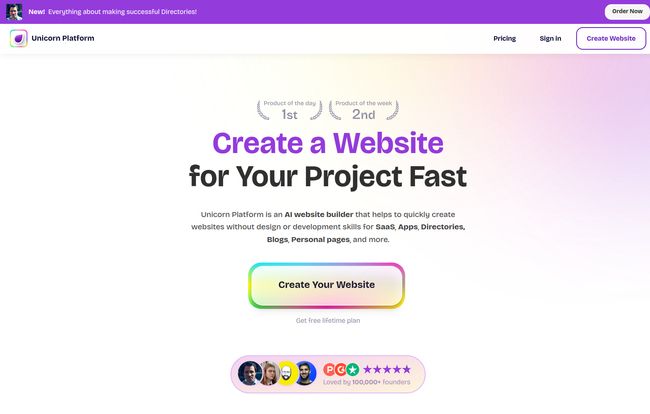
Visit Unicorn Platform
The Features That Actually Matter for a Startup
A tool can look pretty, but if it doesn't have the goods under the hood, it's useless. Here’s where Unicorn Platform shines for its target audience.
The AI Co-Pilot: A Gimmick or Genuinely Useful?
I’ll admit, I rolled my eyes when I saw “AI-Powered.” It’s the marketing buzzword of the decade. But their AI landing page generator is actually quite clever. You feed it a description of your product, and it spits out a full-blown landing page structure with copy. Is the copy perfect? No. But does it demolish writer's block and give you a fantastic V1 to work from? Absolutely. It turns a day of work into an hour of editing. That’s a massive win.
No-Code, But With an Escape Hatch (Custom Code)
This is a big one for me. While the platform is 100% no-code, it doesn't trap you. In the paid plans, you can inject your own custom HTML, CSS, and Javascript. This means if you need to embed a special widget, add a custom tracking script, or just tweak a style beyond the built-in options, you can. It's the flexibility to grow without having to migrate.
Blogging and Content Made Simple
Every startup needs a blog for content marketing and SEO. Unicorn Platform includes a straightforward, integrated blogging system. It's not going to replace a powerhouse like WordPress for a major publication, but for a company blog? It's more than enough. You can write posts, add images, and get your thoughts out there without the security updates and plugin conflicts that make WordPress such a chore.
Let's Talk Money: Unicorn Platform Pricing
Okay, the all-important question. What’s this going to cost? For a startup, every dollar counts. The pricing structure here is pretty transparent and scales logically.
It all starts with the Free 'Lurker' plan. And I love that name. It knows its audience. This plan is perfect for testing the waters. You can build a site, play with all the components, and see if you like the workflow. The catches? You can't publish, so it's strictly for building and previewing. A true 'try before you buy' experience.
To go live, you need to jump to a paid plan. The Maker plan at $14/month is the entry point. It gets you one published website and, crucially, lets you connect a custom domain. This is the bare minimum for any serious project. If you're just launching an MVP or a personal site, this is your ticket.
The Startup plan at $49/month is where things get interesting. You get unlimited pages and blog posts, plus you can start collaborating with a team member. This feels like the sweet spot for a new SaaS or a growing project that's starting to invest in content marketing.
From there, the plans scale up for agencies, freelancers, and bigger businesses with more sites to manage. Here's a quick breakdown:
| Plan | Price (Monthly) | Published Websites | Best For |
|---|---|---|---|
| Maker | $14 | 1 | Solo founders, MVPs, personal sites |
| Startup | $49 | 1 (with ∞ pages/posts) | Early-stage startups, content-focused sites |
| Business | $69 | 3 | Small businesses with multiple brands |
| Freelancer | $99 | 8 | Freelancers building sites for clients |
| Agency | $179 | 20 | Small agencies managing a client portfolio |
Note: Prices are based on the information available at the time of writing. Always check the official pricing page for the latest details.
The Good, The Bad, and The… Unicorn-y?
No tool is perfect. Let's get real about the pros and cons.
What I loved was the sheer speed. The focus on being a tool for busy people isn't just marketing fluff; it's baked into the product's DNA. The AI assistant is a genuinely useful time-saver, and including essentials like a free SSL certificate and CDN on all plans means you don't have to worry about the technical stuff. It just works.
On the flip side, the limitations are real. The free plan is quite restricted—you can't even publish a site. To get rid of the Unicorn Platform branding and use a custom domain, you have to pay. This is pretty standard practice for freemium builders, but it's something to be aware of. If you're looking for ultimate design freedom and thousands of templates, this might feel a bit constrained. But that’s the point. It trades infinite choice for speed and simplicity.
How Does It Stack Up Against The Giants?
It’s tempting to compare Unicorn Platform to everything out there, but that’s not really fair. It’s a specialized tool.
- vs. WordPress: Unicorn Platform is for people who want to set it and forget it. WordPress is for people who enjoy (or have to tolerate) constant maintenance, updates, and tinkering.
- vs. Webflow: Webflow is for designers who want to build complex, highly-customized sites and understand concepts like the box model. Unicorn Platform is for founders who need to build a great-looking site today and get back to working on their product.
- vs. Wix/Squarespace: This is a closer comparison, but Unicorn Platform feels more focused. Its components and overall vibe are geared towards tech, SaaS, and digital products, whereas Wix and Squarespace cast a much wider net for artists, restaurants, and bloggers.
So, Who is Unicorn Platform Really For?
After spending some quality time with it, the ideal user profile is crystal clear. This platform is for you if:
- You're a SaaS founder who needs a marketing site for your product yesterday.
- You're an indie developer launching a new mobile app and need a simple, effective web presence.
- You're testing a business idea and need a quick, affordable way to create a Minimum Viable Product (MVP) landing page to collect emails.
- You value your time immensely and see your website as a tool for business, not an art project.
It’s for the doers, the builders, the people who know that a good-enough website that’s live today is infinitely better than a perfect website that launches next year. It’s a tool that respects your time. And for a busy founder, thats the most valuable feature of all.
Final Thoughts
I came in skeptical, but I'm leaving impressed. Unicorn Platform knows exactly who it's for and what problems it solves. It’s not trying to be the most powerful or the most flexible website builder on the market. It’s trying to be the fastest and easiest for a very specific, and very underserved, group of people. If you fall into that group, I think you’ll find it’s not just a tool, but a genuine business partner that helps you launch and grow. It gets out of your way so you can get back to building. And in my book, that’s a beautiful thing.
Frequently Asked Questions (FAQ)
- Can I use my own domain with Unicorn Platform?
- Yes, you can! But you'll need to be on one of the paid plans, starting with the 'Maker' plan.
- Is Unicorn Platform good for SEO?
- It provides all the basic tools you need for good on-page SEO. You can edit title tags, meta descriptions, image alt text, and the integrated blog is great for content marketing. The sites are also fast and mobile-responsive, which are huge factors for Google.
- Do I need to know how to code to use it?
- Not at all. It's a 100% no-code, drag-and-drop experience. The option to add custom code is there for advanced users on paid plans, but it's not required.
- What kind of integrations does it support?
- It supports a range of form integrations with popular tools like Mailchimp, Zapier, Airtable, and Stripe for payments, which covers most of the essential needs for a startup collecting leads or taking money.
- Is the AI landing page generator actually any good?
- It's surprisingly effective as a starting point. It's not going to write your final, conversion-optimized copy, but it will give you a solid structure and first draft in seconds, which is a huge time-saver.
- Can I remove the Unicorn Platform branding?
- Yes, but you'll need to upgrade to a paid plan. The 'Startup' plan and higher allow you to remove their branding completely.
